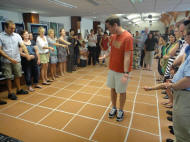GA Conference review
1. Need a good basis of knowledge to build and put concepts into context. -not just 21C skills.
Knowledge is power- when does knowledge turn into understanding?
Why is it important - "pupils across all ages agree that having an excellent knowledge of the subject they are teaching is the most effective quality of a teacher" - Teacher? Facilitaor? or Geographer? -all 3
2. Reassessing Perceptions of the world - Brandt line and HIC/LIC is irrelevant now. Is our knowledge of the world current. keep up to date Hans Rosling- Statistics aren't boring- Be careful the place that we teach doesn't become defined by the issues we are presenting- eg Is Bangladesh just flooding?. Is Brazil a massive favela? - use gapminder for statistics quiz.
IB REVIEW is a thematic approach possible?
-students identify recurring themes to link revision together.
1. Philippinos in HK. 2. Core Periphery idea. 3. Globalization/Global Interactions TNCs, 4. Environmental Sustainability. 5. Appropriate technology. Other concepts = examine- (look at other side too). disparity, empowerment, sustainability.
Not enough time to do interesting teaching. course is interesting and contemporary. teach to the syllabus and use the command terms.
worldmapper, bbc animations YEAR 7
Crossschool mappingGoogle mymaps -sense of place
Tell the story behind a place - emotional.
soundscape - bbc save our sounds. - places of peace,
http://makingmaps.net/
http://mappingweirdstuff.wordpress.com/
nodal map of distance direction from central place to sounds images....
youngpeoplesgeographies
Adam Nichols -knows geography of China - fieldtrip to china
IB REFERENCING & CITATIONS INSET 6/5/11
Use citations tool in word to create bibliography and in text referencing. fill in forms in the toolbox first, then it does it for you.
MLA Referencing Guidance
Academic Honesty ppt
SonofCitationWebsite
SEEDS INSET DAY 11/5/ 2011 full notes:http://www.seedstraining.com/sis511/index.htm
THE BRAIN 101 - Build your Brain Muscle
golden era of neuroscience - One of the fundamental challenges we face in education is learning how to learn. What we know:
- We all have one, Its the same size and shape as everybody else's brain., It has the same parts as other brains...even Einstein's.
- However, the "genius" brain has more connections or "wires" that enable it to move information faster and to engage more of your brain's capacity. (The Neural Pathway)
- These wires can be developed just like a muscle. We could all be geniuses.
- Use your body.
The body generates the electricity your brain needs to power its massive amount of activity. Think of your body as the power plant for your brain. When you use and engage your body you create the energy required to build those new "wires". More wires = more brain capacity. - Try new things.
Babies are the ultimate learning machine. Everyday they explore an exciting new world. They investigate everything with all of their senses. Every time that we try something new we fire up a new connection. When we practice that new behavior the connections get stronger and deeper...eventually becoming a habit...or something that we can do comfortably. Try new things everyday to keep your brain developing. Talk to new people. Go to new places. Try a new sport. Try a new musical instrument. Challenge your brain with new experiences and reap the rewards.
The EARN Model : Consider these factors and move through the paradigms that limit education.
The Group Juggle Activity
The group juggle activity challenged the teams to make progress...fast. With only a few rounds of practice, each team made tremendous strides and their times were reduced drastically. Here are the key learning points from the activity:
BOOKS1. Practice makes progress.
Each time we practiced, we made progress. That's should be our aim with our students as well. Let's support them in making small, measurable improvements each time they work.2. Success can look different.
Every team was successful...and every team achieved their success in a different way. This is important to keep in mind when we work with students. They don't need to be just like everybody else, in fact they need to find ways that work for them as an individual. We are not developing clones, we are developing young people who are aware of their strengths and challenges.3. Sharing ideas leads to breaking paradigms.
Progress got easier when we got a bit creative. When we tried new ideas and began to challenge the definitions of the rules, we found space to work in ways that enabled tremendous improvement. Getting better doesn't have to be hard...in fact, most successful people have found simple things that they can do repeatedly to become successful. Challenge your assumptions.4. Work smarter not harder.
Remember the story of the chicken and the dog. Success is often found when we dare to re-examine our situation and eliminate a behavior that isn't getting us positive results. If something isn't working, try a new approach.
Brain Rules by John Medina A great synopsis of modern brain research. This book breaks it all down and illustrates what is most relevant and useful.
How Your Child Is Smart by Dawna Markova Understand the learning styles and ways to tap into your child's learning potential.
Seven Kinds of Smart by Thomas Armstrong Learn about the theory of the Multiple Intelligences.
Major In Success by Patrick Combs A great resource for college bound youth or teens in transition.
How Your Child Is Smart by Dawna Markova Understand the learning styles and ways to tap into your child's learning potential.
Seven Kinds of Smart by Thomas Armstrong Learn about the theory of the Multiple Intelligences.
Major In Success by Patrick Combs A great resource for college bound youth or teens in transition.
Spark: The Revolutionary New Science of Exercise and the Brain The connection between physical activity, emotional health, and brain-based learning capability has never been clearer...a must read.
